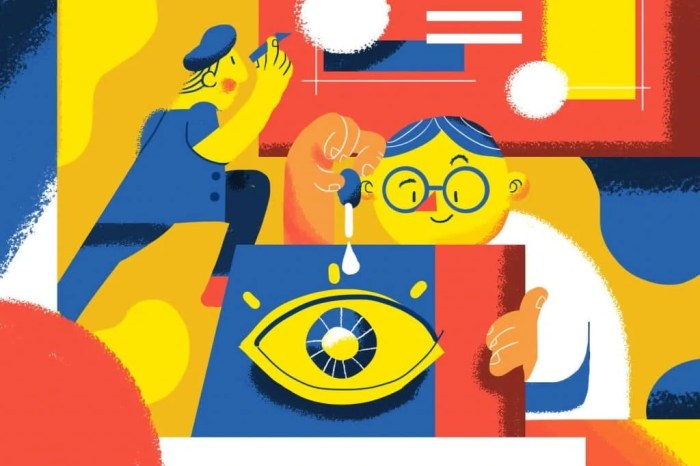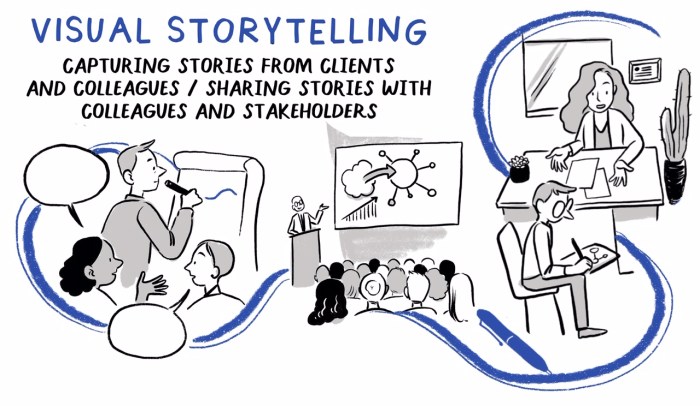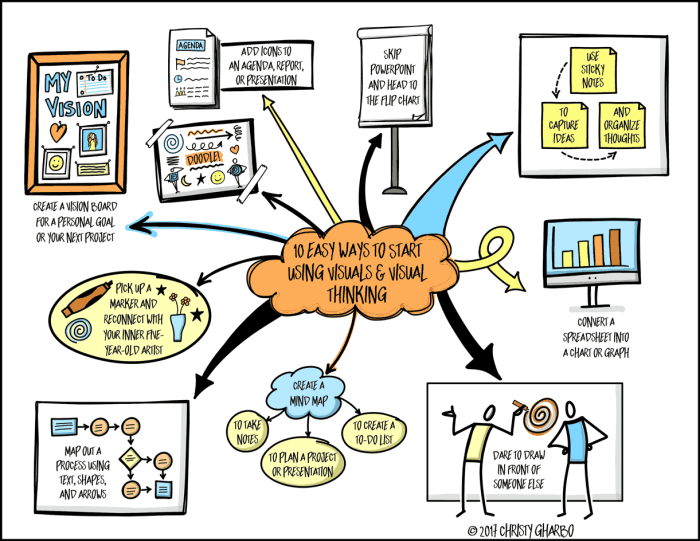Visual storytelling transcends mere aesthetics; it’s about crafting a compelling narrative that resonates deeply with the viewer. This exploration delves into five key strategies for designing visuals that not only capture attention but also effectively communicate a message, evoke emotion, and leave a lasting impression. We’ll examine the narrative arc, explore the power of visual elements, and discuss how to apply these principles across various formats, from animation to website design.
From understanding the fundamental principles of narrative structure to mastering the nuances of color palettes, typography, and visual metaphors, we will equip you with the tools to transform your visuals from static images into dynamic narratives. We’ll cover practical techniques and provide real-world examples to illustrate the effectiveness of each approach, demonstrating how to create visuals that truly connect with your audience on an emotional level.
Understanding Narrative Structure in Visual Design

Effective visual storytelling hinges on a strong understanding of narrative structure. Just as a compelling written narrative employs a clear beginning, middle, and end, so too must visual designs guide the viewer through a coherent and engaging experience. This involves carefully considering the sequence of visuals, the emotional arc, and the use of symbolic language to convey meaning effectively.
Visual Narrative Arc: Product Journey
A product’s journey from concept to market launch can be effectively visualized using a series of images. Imagine a sequence beginning with a rough sketch on a napkin (representing the initial idea), progressing to detailed design schematics (the development phase), followed by images of manufacturing, rigorous testing, and finally, the product’s launch event with happy customers. Each image should be visually distinct yet cohesively linked, showcasing the transformation and effort involved in bringing the product to life. The final image could depict the product successfully integrated into the consumer’s life, fulfilling its intended purpose. This visual progression mimics the classic hero’s journey narrative arc, making the product’s story more relatable and engaging.
Storyboard: Emotional Progression in an Advertisement
Consider a storyboard for an advertisement promoting a new eco-friendly cleaning product. Scene 1: A cluttered, dirty kitchen, emphasizing the viewer’s frustration and overwhelm. Scene 2: The introduction of the cleaning product, depicted as sleek and efficient, offering a sense of hope and possibility. Scene 3: The product in action, effortlessly cleaning the kitchen, accompanied by uplifting music and bright lighting, showcasing ease and efficacy. Scene 4: A sparkling clean kitchen, filled with natural light and the family enjoying the space, signifying a feeling of accomplishment and satisfaction. Scene 5: A final shot highlighting the product’s eco-friendly packaging, leaving the viewer with a positive association and a sense of responsibility. This storyboard illustrates a clear emotional progression, moving the viewer from negative feelings to positive ones, ultimately persuading them to purchase the product.
Color Palettes and Emotional Impact
Color palettes are powerful tools for evoking specific emotions and driving the narrative forward. A calming, natural palette of greens, blues, and earth tones might be used to promote a sense of tranquility and connection with nature, perhaps for a brand selling organic products. Conversely, vibrant reds and oranges could be used to evoke excitement and energy, ideal for a sports drink advertisement. A sophisticated palette of deep blues, purples, and golds might project luxury and elegance for a high-end fashion brand. The strategic use of color helps to reinforce the overall message and creates a subconscious emotional response in the viewer.
Symbolism and Metaphor Across Cultures
Symbolism and metaphor are powerful tools in visual storytelling, but their interpretations can vary significantly across cultures. For example, the color white often symbolizes purity and innocence in Western cultures, while it can represent mourning or death in some Eastern cultures. Similarly, a specific animal might hold a positive connotation in one culture but a negative one in another. A visual narrative needs to be mindful of these cultural nuances to avoid misinterpretations and ensure its message is effectively conveyed to the intended audience. A careful consideration of cultural contexts is crucial for successful global campaigns. For instance, a heart symbol universally represents love, but its visual representation might vary subtly.
Visual Elements for Effective Storytelling

Effective visual storytelling relies on a skillful combination of design elements to convey a narrative compellingly. The choice of visual style, metaphor, typography, and even the decision between photography and illustration all significantly impact the viewer’s understanding and emotional response. This section explores several key visual elements that contribute to a successful visual narrative.
Infographic Styles for Storytelling
Three distinct infographic styles can be used to tell the same story, each offering a unique perspective and engagement level. Let’s imagine the story is about the increasing global adoption of renewable energy sources.
Minimalist Infographic: This style prioritizes simplicity and clarity. Imagine a clean, white background with a single, bold line graph illustrating the upward trend of renewable energy adoption over time. Perhaps three or four key data points are highlighted, with concise labels. The color palette would be limited, possibly using only two or three colors, for a sophisticated and uncluttered aesthetic. The focus is on the data’s essential message, presented with minimal visual distraction.
Maximalist Infographic: In contrast, a maximalist approach embraces visual richness and detail. This infographic might use a vibrant, varied color palette. The same renewable energy data could be presented through a combination of charts (bar charts showing energy source distribution, pie charts representing market share), icons (representing different renewable energy technologies), and even small illustrations showing people using renewable energy sources. The design would be busier, aiming for visual stimulation and a more immersive experience.
Data-Driven Infographic: This infographic prioritizes data visualization. It could use interactive elements, such as clickable charts that reveal more detailed information when selected. The story of renewable energy adoption would be presented through a variety of data visualizations: maps showing regional adoption rates, animated charts showing growth over time, and perhaps even a small interactive world map showing renewable energy production locations. The focus is on the sheer volume and depth of the data, allowing viewers to explore the story at their own pace.
Visual Metaphors for Innovation and Growth
Visual metaphors can powerfully convey complex concepts. Consider these three metaphors for “innovation” or “growth”:
1. A Seed Growing into a Tree: This metaphor effectively illustrates the process of growth. The small, vulnerable seed represents the initial idea or concept, while the large, flourishing tree symbolizes the mature, successful outcome. The journey from seed to tree visually represents the challenges, growth, and eventual success of innovation.
2. A Network of Interconnected Nodes: This metaphor emphasizes collaboration and interconnectedness as drivers of innovation. Imagine a network diagram with nodes representing individuals or organizations involved in the innovation process. The connections between nodes illustrate the collaborative efforts and knowledge sharing that fuel growth and advancement. This visual metaphor highlights the collaborative nature of innovation.
3. A Mountain Climber Reaching the Summit: This metaphor highlights the challenges and triumphs inherent in innovation. The arduous climb represents the obstacles and hard work required to achieve innovation. Reaching the summit symbolizes the ultimate success and reward. The visual representation of the struggle and eventual victory makes the concept more relatable and engaging.
Typography for Emphasis, Suspense, and Guidance
Typography plays a crucial role in guiding the viewer’s eye and creating emotional impact.
Consider using a bold, sans-serif font like Roboto for headlines to create emphasis and direct attention to key information. A more delicate script font, such as Pacifico, could be used for less critical text or to evoke a sense of elegance or sophistication. For building suspense, one might use a progressively larger font size as the narrative progresses towards a climax, or employ a slightly distorted or shadowed font to create a more dramatic effect. To guide the viewer’s eye, strategically placed arrows, contrasting colors, or carefully chosen font weights can lead the viewer through the visual narrative.
Photography versus Illustration in Storytelling
| Visual Style | Emotional Impact | Cost | Time Investment |
|---|---|---|---|
| Realistic, detailed representation of reality | Can evoke strong emotional responses, depending on the subject matter and photographic style. High potential for authenticity and relatability. | Can range widely, from relatively inexpensive stock photos to expensive professional shoots. | Can vary depending on the complexity of the shoot, post-processing, and location. |
| Stylized, often symbolic representation; can range from realistic to abstract | Offers flexibility in controlling emotional impact through style and color choices. Can be more easily adapted to a specific brand or style guide. | Costs depend on the artist’s experience and the complexity of the illustration. Can be less expensive than professional photography in some cases. | Illustration can be a time-intensive process, particularly for complex pieces. |
Applying Storytelling Principles to Different Visual Formats

Adapting storytelling techniques across various visual media requires understanding the unique strengths and limitations of each format. Effective storytelling transcends the medium; the core principles remain consistent, but the execution differs significantly. This section explores how to apply these principles to animation, website design, video series, and single-image storytelling.
Animated Sequence Illustrating a Problem and Solution
A simple animation can powerfully convey a narrative. Imagine a sequence using only shape and color to illustrate a common problem: dehydration.
Step 1: The animation begins with a vibrant, bright blue circle representing a full water bottle. This is accompanied by a cheerful, sun-yellow square representing a person feeling energized and healthy.
Step 2: Over time, the blue circle gradually shrinks, becoming smaller and less vibrant, transitioning to a dull, light blue. Simultaneously, the yellow square becomes muted, turning a pale, sickly yellow, and perhaps even developing cracks to visually represent fatigue.
Step 3: A red triangle appears, representing thirst and discomfort. The red triangle grows larger as the blue circle shrinks further.
Step 4: The animation then shows the blue circle refilling, regaining its vibrant color and size. The red triangle shrinks and disappears. The yellow square brightens and the cracks vanish, returning to its original sunny yellow.
Step 5: The animation concludes with both the fully restored blue circle and the bright yellow square, emphasizing the resolution of the problem.
Website Homepage Telling a Brand Story
A compelling website homepage can encapsulate a brand’s narrative. Consider a coffee company, “Morning Brew.” The homepage would feature a large, high-quality image of someone enjoying a cup of coffee in a naturally lit, cozy setting. The image establishes the brand’s atmosphere. Below the image, a concise tagline – “Your Daily Ritual, Reimagined” – would grab attention. Further down, short, impactful paragraphs would explain the company’s mission: ethically sourced beans, sustainable practices, and a commitment to quality. Interactive elements could include a rotating carousel of customer testimonials, a link to their bean origin stories, and a prominently displayed “Shop Now” button. The overall design would emphasize clean lines, warm colors, and high-resolution imagery, consistent with the brand’s message of quality and comfort.
Series of Short Videos Creating a Cohesive Narrative Arc
A series of short videos can build a compelling narrative through episodic storytelling. Consider a series promoting a new fitness app.
Video 1: Introduces the protagonist, a busy professional struggling with a sedentary lifestyle. The video highlights the challenges of finding time for exercise.
Video 2: Shows the protagonist discovering the app and its user-friendly interface. The video focuses on ease of use and accessibility.
Video 3: Depicts the protagonist using the app, experiencing positive changes in their fitness levels and overall well-being. The video shows the app’s features in action.
Video 4: Showcases the protagonist achieving their fitness goals, feeling confident and energized. The video emphasizes the transformation and results.
Video 5: A call to action encourages viewers to download the app and start their own fitness journey. The video reinforces the app’s benefits.
Single Powerful Image Telling a Complete Story
A single image, skillfully composed, can convey a powerful narrative. Consider Dorothea Lange’s iconic photograph “Migrant Mother,” taken during the Great Depression. The composition centers on a woman, her face etched with worry, her gaze downcast, yet her children clinging to her. The muted color palette, dominated by browns and grays, reflects the harsh realities of poverty and hardship. The subject matter – a mother and her children – immediately evokes empathy and understanding. The image tells a story of resilience, struggle, and the enduring strength of the human spirit without a single word. The composition, the color, and the subject matter work in harmony to create a narrative that resonates deeply.
End of Discussion

Mastering the art of visual storytelling is about understanding your audience, choosing the right visual language, and crafting a narrative that is both engaging and memorable. By thoughtfully considering narrative structure, effectively utilizing visual elements, and adapting your approach to different formats, you can create visuals that not only inform but also inspire and move your audience. Remember, a well-crafted visual narrative is more than just an image; it’s an experience.